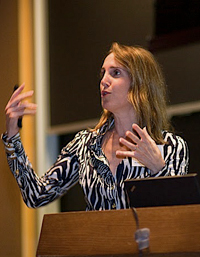Bonnie Berger
Professor of Applied Mathematics, 1992-Present
Research: Theoretical Computer Science, Computational Biological Modeling
Website: http://people.csail.mit.edu/bab/

Bonnie has loved mathematics since childhood when she would watch her father solve problems. "Can I have some?" she would ask, and her father would slip them under her door. Years later, Bonnie's 12th grade calculus teacher told her that women had no future in math. Little did he know, he was discouraging the woman who, thirteen years later, would be a leading figure in Applied Mathematics.
Bonnie earned her PhD in computer science at MIT, and completed post-doc work in applied mathematics soon after. In 1992, she became a professor of mathematics. And in 1999, she made tenure - the first female in the MIT math department to earn tenure since the 1970s. In between those landmark career events, her studies have taken her on a cross-disciplinary journey right to the place where math and biology collide.
Bonnie likens her academic endeavor to a radio mash-up. Just as a station may play a variety of music, she uses concepts from mathematics, genomics, and theoretical computer science in her everyday work. Because of that, she can invent novel mathematical tools for emerging ideas in biology. "I don't just stick with one hammer," she says. "My question is: what are the problems in biology that math can be applied to?"
As head of the MIT Computation and Biology Group, Bonnie designs algorithms that can predict the shapes of folded proteins. The tools that she and her students build have relevance to urgent biological challenges, such as cracking the shell of the AIDS virus.
One of her most interesting observations came from a particular crossover between math and biology called comparative genomics. She remembers looking across genomes of different species on a computer screen. "You could really take genetic information from an organism, like a fly, and apply it to another organism. We are not that different from other living things, especially other mammals," she says. "It was remarkable."
Bonnie acknowledges that her career comes with unique struggles. With two children, Alex, 13 and Rachel, 11, a husband, memberships in a variety of MIT groups, and a passion for tennis and swimming, all on top of being a top researcher in her field, no one would doubt the strain on time and cognitive resources. But bursting with energy and palpable enthusiasm, she has the personality to match any challenge, mathematical or otherwise. "I'm always game," she says.
Bonnie's Dayhoff-award-winning success comes from a unique ability to multi-task and a disciplined, fine-tuned schedule.
She compartmentalizes her time in a way so that her different activities do not seep into one another. When she's with her kids, she's not on the phone. And when she really has to get work done, she's in a coffee shop - not in her office where distractions abound. Also key is her supportive husband who has a deep respect for her career.
"It's hard, but it's doable," Bonnie says of being a female professor in mathematics. "You have to protect your time, be careful what you agree to do, find a balance, and keep the big picture in mind." More than anything, she wants to see women breaking into higher level careers in mathematics. For girls with a passion for numbers, she has one simple message: "There's no reason you can't do math."
